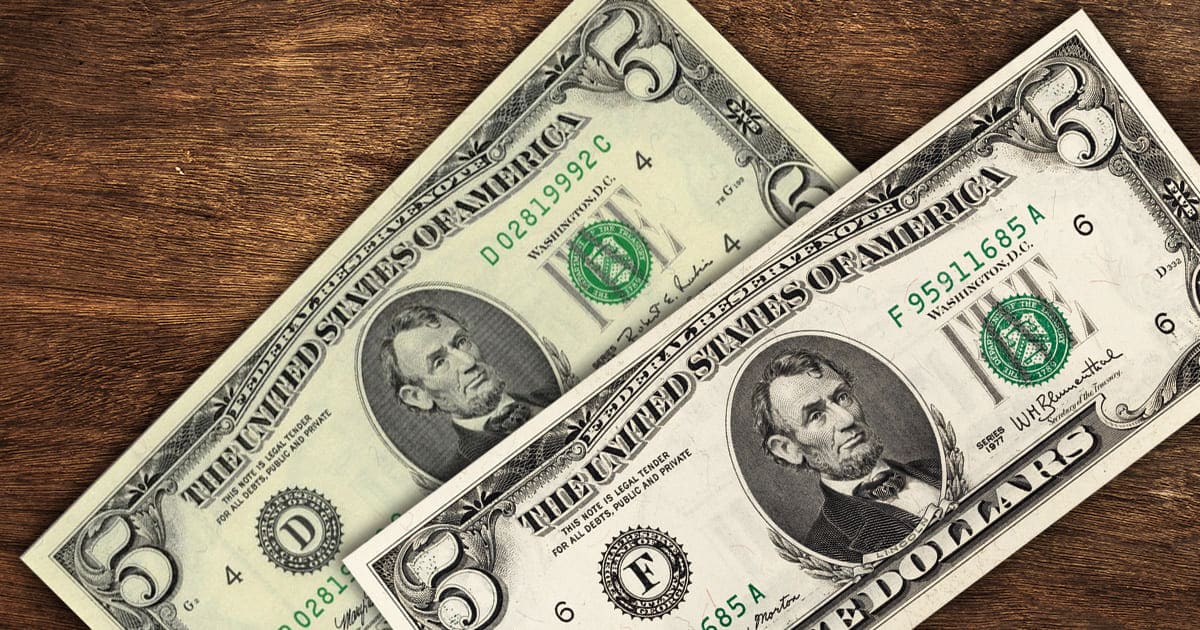
What are the Grades for Paper Money?
If you’re new to the world of currency collecting and want to learn more about the grades of paper currency, you’re in the right place.
What Does it Mean for Currency to be Graded?
To effectively buy or sell currency, both parties of a given transaction need to agree on a grade so that a fair price can be set. The value of a piece of paper money is dependent on its condition, scarcity, and eye appeal. Without a third-party grade, selling or insuring that currency beyond its face value will be difficult.
There are many currency-grading organizations, although the Professional Currency Grading Service (PCGS) and Paper Money Grading (PMG) are two of the most widely used, so let’s focus on those, starting with PCGS.
Both organizations use a scale of 1-70 to certify and grade paper currency, but there are some differences in those categories. Some of these are simply differing terminologies to describe the same thing; other differences are in the standards for the respective grades.
PCGS Currency Grading
PCGS Designations
PCGS has two designations to distinguish notes: Premium Paper Quality and Details.
Premium Paper Quality
PPQ is a designation reserved for notes with the hallmarks of total originality and outstanding quality paper for the grade. These notes have no visible evidence of restoration and possess hallmarks of original paper quality, including paper wave, bold printing color, and eye appeal.
Details
When a numerical grade does not faithfully describe the state of a banknote, a Details grade is used. Details may be assigned if the note exhibits issues that exceed the expectations for a given grade. Generally, lower grades are allowed more issues before implementing a Details designation. When the Details grade is used, the note is given a numerical grade independent of the problem, and the reasons behind the Details will be noted on the label. PCGS’s Banknote Guarantee does not apply to Details notes.
PCGS Currency Grades
Superb GEM Uncirculated 67-70 PPQ
70 PPQ indicates a Supreme Gem Uncirculated state- the highest score PCGS gives paper money. Notes with this grade have full margins centered and aligned registration to the naked eye. These banknotes cannot have imperfections or any marks from handling.
A grade of 69 PPQ is used for notes that have the slightest misalignment and have registration just off to the naked eye. Banknotes with perfect alignment with minor handling or printing imperfections could also be graded a 69 PPQ.
PPQ 68 banknotes demonstrate full margins that may be slightly off-center or display a slight shift in registration. If the banknote has a large registration shift, it may not be eligible for this grade. Slight handling is acceptable, but any handling greater than slight may be scored lower than a 68.
A PPQ 67 must have full margins and “pleasing centering” that is not far from alignment. Notes in this grade can have light handling, provided it is not distracting.
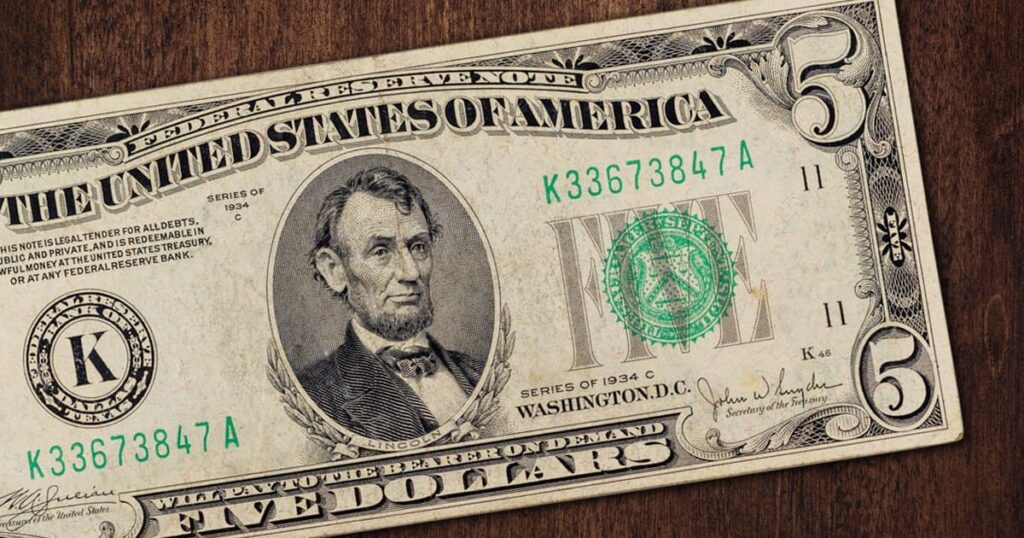
Gem Uncirculated 65-66 PPQ
Banknotes in the 66 grade will still have pleasing centering but can be less aligned than notes in the 67 grade. These notes are allowed more light handling, provided it is not too distracting, unless the note would score a 68 based on centering and margins.
A 65 requires the note to have full margins and reasonable centering. These notes can be visibly off but not so far that the margin comes too close to the design frame. These banknotes are allowed more light handling than those in the 66 range, but excessive handling can result in a 64. A Superb Gem may have enough handling marks to reduce the grade to 65, and some Gem banknotes must retain reasonable levels of embossing on intaglio notes. Light embossing may result in a lower grade.
Choice Uncirculated 62-64
64 is the highest non-PPQ grade assigned. These notes will demonstrate margins out of alignment, which may not be full for the issue. Banknotes in the 64 grade are allowed more handling, including a slightly bent corner or a distracting crinkle.
Notes with a Choice Uncirculated 63 grade can display margins more considerably misaligned, and the margins do not need to be full. These notes are allowed even more handling, including corner tip folds outside the design as well as heavier bends. Banknotes that would otherwise be Gems but contain up to two pinholes or small margin tears that do not result in a label comment could be graded a 63.
Uncirculated 60-62
A grade of 62 applies to uncirculated notes with poor centering that omits one margin and interrupts the design. Banknotes with folds of up to two corner tips not extending into the design could be graded a 62. The 62 grade also includes more serious issues like foxing tiny tears of the margin or heavy handling.
Currency graded 61 is less common than 62. Notes in the 61 grade have poor eye appeal and are often strictly uncirculated with detracting factors that do not merit a comment on the label. Centering that interrupts the design, minor issues like serious foxing, light staining, small tears in the margin, and multiple corner folds that do not reach the design can warrant an Uncirculated 61 grade.
A grade of Uncirculated 60 is uncommon. Notes in this category will demonstrate numerous minor issues, but not enough to note on the label. These will more than likely have a negative eye appeal compared to higher Uncirculated grades.
Choice About Uncirculated
Common Choice About Uncirculated 58 notes have more severe bends and folds, with less eye appeal than the Uncirculated grades. These will often display vertical folds or single corner folds that extend into the note’s design. Some notes that would otherwise receive the Uncirculated label demonstrate excessive handling that appears more like an About Uncirculated note. These may have rounded corners that should be sharp or roughed up edges when the banknote itself does not have a fold in the design.
About Uncirculated 50-55
A 55 note will often have a horizontal fold or a hard vertical fold. Two light folds or a single average fold on a banknote with excessive handling can warrant an About Uncirculated 55 grade. Notes that would be graded Choice About Uncirculated 58 with centering issues severe enough that the design runs off the paper may receive this grade.
About Uncirculated 50 grade is commonly used for Choice XF notes with folds and wear minor enough that they do not greatly impact eye appeal. This grade may also be used for banknotes that would receive a higher AU score but have poor eye appeal.
Choice Extremely Fine 45
The typical 45 will have three moderate vertical “storage folds,” as notes in this level have seen brief circulation. A moderate vertical and horizontal fold or two very hard folds may also merit a score of 45.
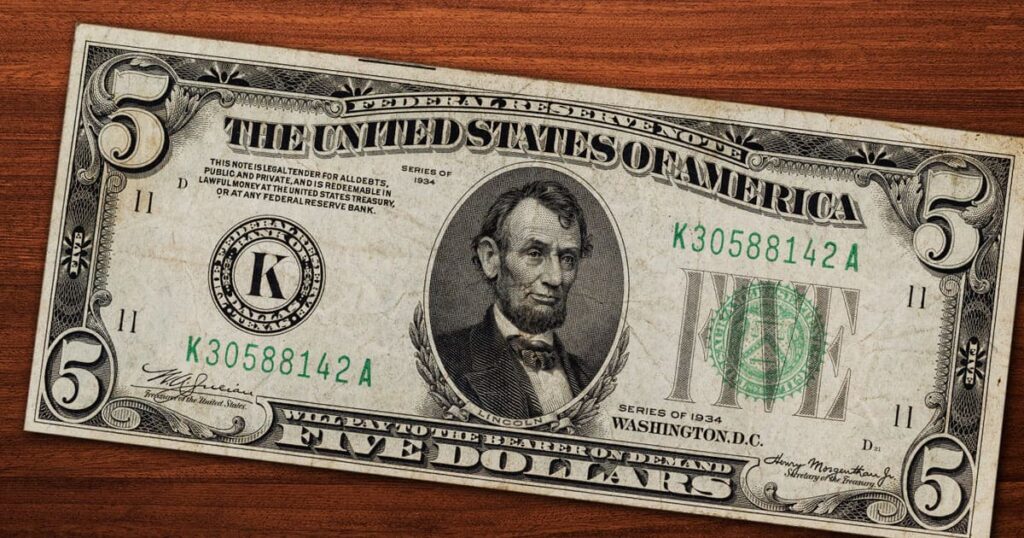
Extremely Fine 40
Many 40’s will demonstrate folds like those in the Very Fine category, but these folds will be light. Extremely Fine banknotes will have minimal wear and excellent eye appeal. 45’s can be downgraded to a 40 if they demonstrate hard folds or other factors that negatively impact eye appeal.
Choice Very Fine 35
Very Fine notes often have a horizontal fold and three or more vertical folds. If these folds are distracting and reduce the eye appeal of the note, it may fall into the Very Fine grade instead.
Very Fine 20-30
Both the folds and the wear on a 30 will be more noticeable than on a 35, but not hard enough to break the paper, as seen in the 25 range. A banknote otherwise graded 35 could reach a 30 if a detracting factor affects eye appeal.
Banknotes graded 25 will have typical Very Fine-level folds that will be harder and more distracting to the eye. 25’s should still have “snap” left in the body of the paper.
20 is an intermediary grade, denoting that the note is in better condition than a Choice Fine 15, but still falls short of the Very Fine 25 grade. These will have decent body, typical Very Fine folds, and may exhibit moderate crumpling throughout the note. If the note has too much wear around the focal points or edges, its score may be reduced to a 15.
Choice Fine 15
Notes with a grade of 15 will have some snap left to the paper but display greater wear than those in the Very Fine range. This may result from typical VF folds with a more extreme centerfold that has lost rigidity in the fold itself. Folds of this sort are visually distracting in key focal areas like central vignettes and portraits.
Fine 12
Fine notes have many of the same characteristics as a Choice Fine note but display edge fraying or are too worn to classify as CF. To achieve a Fine score, there must be moderate body remaining.
Very Good 8-10
Notes graded a 10 display quite a bit of overall wear and have little body remaining but are still bright in design. Minor issues that warrant a comment on higher grades will be found on these notes without mention. Banknotes on this level are likely to have heavier soiling, and when they arrive at a bank in this condition, they are typically destroyed.
Notes with a score of 8 are slightly more aesthetically pleasing than those with a score of 6 but have almost no remaining body. The design of an 8 will be less worn than a 6.
Good 4-6
Soft notes with all body lost in circulation are typical of grade 6. Design elements will be considerably worn throughout the notes with splits, tears, and holes. Potential Very Good banknotes missing small pieces may arrive in the Good range.
Notes that are graded 4 have more significant wear to the design throughout the note and will be missing small pieces.
About Good 3
About Good banknotes typically have missing pieces, with heavy wear on the design elements. These notes will be delicate to the touch.
Fair 2
Fair notes still have most of their paper but will be missing larger pieces. Notes in this grade will demonstrate extreme wear and very negative eye appeal.
Poor 1
To be categorized as Poor, banknotes must be identifiable by their catalog number. It is uncommon for a note to circulate until it becomes Poor from wear. These notes will be extremely worn, and the paper will fall apart. Most banknotes are repaired before reaching this state, and an unrepaired Poor note is rare.
PMG Currency Grading
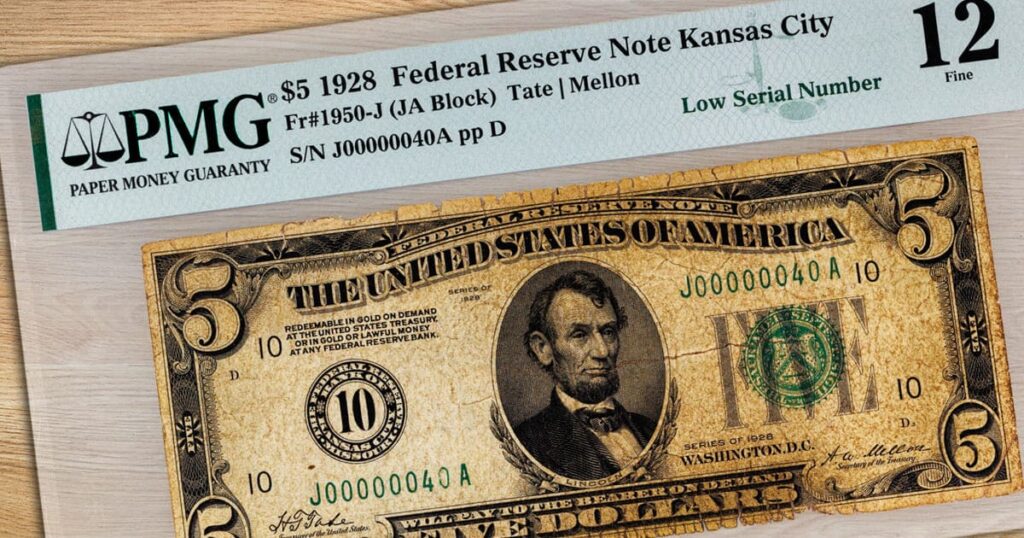
PMG Designations
Exceptional Paper Quality
Exceptional Paper Quality (EPQ) notes will be free of chemical, physical, and material processing to give the note a higher grade. Banknotes graded Very Fine 20 and higher with normal wear for their grade are eligible to be classified as EPQ. To be considered for Gem Uncirculated 65 or higher, a note must qualify for an EPQ designation.
The PMG standard for EPQ is similar but not identical to PCGS’s Premium Paper Quality.
PMG Star Designation
The PMG Star Designation exemplifies exceptional eye appeal for a given grade. Grading based on eye appeal is subjective, but numismatists use standards to define and validate exceptional eye appeal. These standards include demonstrating very strong plate and/or overprint embossing, the vibrancy of color, and paper quality that surpasses the EPQ standards.
All U.S. and world banknotes are evaluated for the PMG Star Designation. Notes that do not qualify for the EPQ Designation are disqualified for the Star Designation.
NET
The NET designation demonstrates that a banknote has issues more severe than the grade will reflect. Notes that receive the NET label will have the problematic elements identified in grading. The grade of the PMG Guarantee does not apply to the grade assigned to these notes but guarantees that the note is genuine.
The PMG NET designation is similar but different from the PCGS Details designation.
PMG Currency Grades
70 GEM Uncirculated
70 ★ EPQ is the highest grade that PMG assigns to paper money. To qualify for this grade, notes show no evidence of handling visible at a 5x view, in addition to centered registration and margins, as visible to the naked eye. Banknotes must qualify for the Star Designation to be graded 70.
Superb Gem Uncirculated 65-69
To be graded 69 EPQ, a banknote must show no evidence of handling as visible to the naked eye. A 69 EPQ’s margins may appear slightly off from the center.
A 68 EPQ grade demonstrates mildly off-center margins and registration. Notes with a 68 EPQ grade may show signs of very minor handling.
To receive a 67 EPQ grade, notes must possess above-average registration and margins. Notes in this grade may show minor evidence of handling.
A 66 EPQ graded note will exhibit slightly more handling than a 67 EPQ note, with above-average centering.
Banknotes with better than average centering but which have one or two small distractions from handling are graded a 65 EPQ.
Choice Uncirculated 63-64
To be graded 64, notes may be off-center on one or two sides. Some evidence of handling is acceptable, but the presence of any folds will disqualify notes from the 64 grade.
Notes graded 63 can have imperfect centering and a flat design. Notes in this grade may display some flaws but no folds.
Uncirculated 60-62
Uncirculated 62 banknotes are strictly uncirculated but may have corner tip issues or minor to moderate evidence of handling. The margins may touch or come into the design, but there are no folds through the design.
A grade of 61 applies to poorly centered paper money with margins that come into the design. These notes might have smudges, counting marks, and other signs of handling. To be graded 61, a note must have no folds through the design.
Currency with a grade of 60 may have problems, including toned paper, fading, or a small stain. These notes will have no folds through the design, but there will be issues from handling.
Choice About Uncirculated 58
The Choice About Uncirculated 58 grade often indicates a note without major issues, except for a single fold that crosses the design.
About Uncirculated 50-55
Notes given the grade About Uncirculated 55 commonly have one fold or two to three corner folds through the design.
Currency with one horizontal fold or two vertical folds is assigned grade 53. Notes in this grade may have signs of handling as well.
Banknotes graded 50 will have two heavy folds or light vertical and horizontal folds with significant handling.
Choice Extremely Fine 45
Paper money graded Choice Extremely Fine 45 will have two or three heavy folds and one might be horizontal.
Extremely Fine 40
Currency with the grade Extremely Fine 40 will have three or more folds, one of which may be horizontal.
Choice Very Fine 35
Notes in the Choice Very Fine 35 grade have also been called Very Fine to Extra Fine, as the note looks Extremely Fine but may have four to seven light folds.
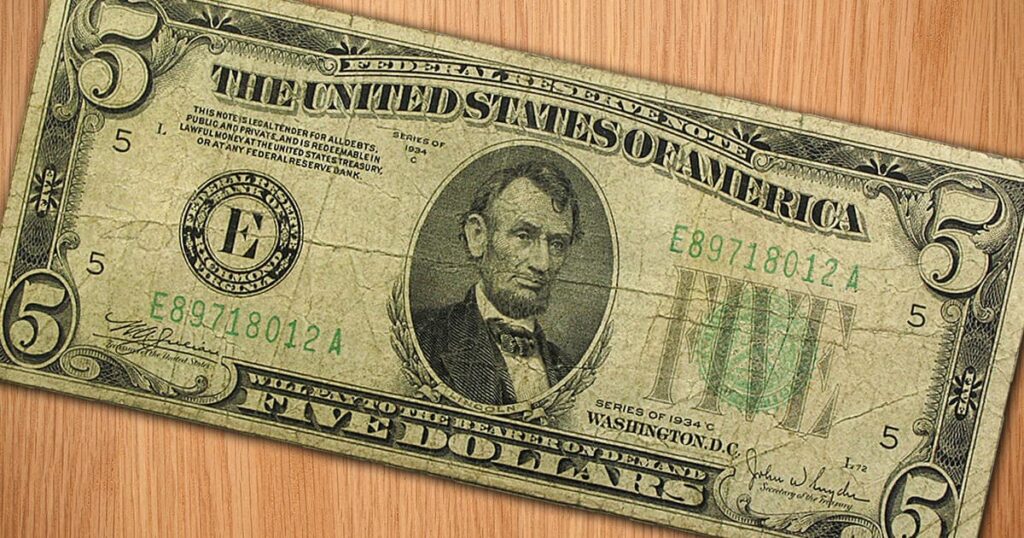
Very Fine 20-30
Banknotes graded Very Fine 30 will show light evidence of circulation, with 7 to ten folds and a potential for light soiling.
Paper money graded 25 will show modest evidence of circulation, more than 7 to 10 folds, and greater soiling than notes graded 30 or higher.
To receive a grade of 20, notes may be moderately circulated with mild soiling and numerous folds. While there will be no serious problems, there might be minor detractions.
Choice Fine 15
Banknotes with a Choice Fine 15 grade might look Very Fine, but closer examination will reveal too many folds or circulation to merit the Very Fine grade.
Fine 12
At grade Fine 12, there will be rounded corners, margin splits, and other issues associated with considerable circulation. To be graded 12, a note must be whole, with solid paper.
Very Good 8-10
Paper money with a grade of 10 will lack crispness. These notes will be very limp and display numerous minor issues.
Currency graded an 8 will be intact and show signs of heavy circulation. There may be small pieces missing from this limp banknote. In this grade, soiling, splits, or light stains are common.
Good 4-6
Notes with a grade of 6 will be very worn, displaying fraying margins, serious splits, and damage.
The lowest grade assigned by PMG is 4. Banknotes in this grade are heavily circulated and have numerous issues, including a total lack of crispness and very poor visual appeal. Notes missing pieces are commonly seen in this grade.
Shop our broad selection of NGC and PCGS-graded currency and add historic banknotes, Federal Reserve Notes, and even confederate currency to your collection today!





